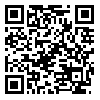Volume 1, Issue 3 (Journal of Clinical and Basic Research(JCBR) 2017)
jcbr 2017, 1(3): 29-35 |
Back to browse issues page
Abstract: (3744 Views)
Introduction: Nowadays, musculoskeletal disorders (MSDs) are one of the most common work-related problems in the world. The aim of this present study was to determine the prevalence of MSDs and their relationship with work-related factors among tutors working at Shahid Sadoughi University of Medical Sciences in Yazd, Iran. Materials and Methods: This cross sectional study was conducted on 113 tutors at the Shahid Sadoughi University of Medical Sciences in 2015. Data were collected by a standard self-administered questionnaire consisting of three major parts: a) demographic and work-related variables, b) musculoskeletal symptoms, c) a modified version of the Standard Nordic Questionnaire. The data were analyzed by SPSS (version 16) using appropriate statistical tests. P-values less than 0.05 were considered statistically significant. Results: Pain in the low back (27.9%) and neck (25%) was the most common complaint among the subjects. Overall, 80 tutors (70.79%) had symptoms of pain in at least one part of the body in the past year. The highest rate of complaints was related to laboratory tutors (94.73%). There was a statistically significant association between prevalence of MSDs and teaching time. Conclusions: The prevalence of MSDs among faculty members of Shahid Sadoughi University of Medical Sciences is high and more than the general population. The musculoskeletal complaints are significantly associated with teaching time.
Article Type: Research |
Subject:
Basic medical sciences
References
1. Vanwonterghem k. Work-related musculuscletal problems: Some ergonomic considerations. J Hum Ergol. 1996; 25(1):5-13.
2. Santos AC, Bredemeier M, Rosa KF, Amantea VA, Ricardo MX. Impact on the quality of life of an educational program for the prevention of work-related musculoskletal disorders: a randomized controlled trial. BMC public health. 2011; 11: 60. [DOI:10.1186/1471-2458-11-60]
3. Pollack R. Dental office ergonomics: how to reduce stress factors and increase efficiency. J Can Dent Assoc. 1996; 62(6):508-10.
4. Shahnavaz H. Workplace injuries in the developing countries. Ergonomics 1987; 30(2): 397-404. [DOI:10.1080/00140138708969725]
5. National Research Council and Institute of Medicine.Musculoskeletal disorders and the workplace;low back and upper Extremities. Washington,DC: National Academy Press; 2001.
6. Campo M, Weiser S, Koenig KL, Nordin M. Work-related musculoskeletaldisorders in physical therapists: a prospective cohort study with 1-year follow-up. PhysTher. 2008; 88(5): 608 – 619. [DOI:10.2522/ptj.20070127]
7. Lorusso A, Bruno S, L\'Abbate N. Musculoskeletal complaints among Italian X-ray technologists. Ind Health. 2007; 45(5): 705 – 708. [DOI:10.2486/indhealth.45.705]
8. Ylipaa V, Szuster F, Spencer J, Preber H, Benko SS, Arnetz BB. Health, mental well-being, and musculoskeletal disorders: a comparison between Swedish and Australian dental hygienist. J Dent Hyg. 2002; 76(1): 47 – 58.
9. Meijsen P, Knibbe HJ. Work-related musculoskeletal disorders of perioperative personnel in the Netherlands. AORN J. 2007; 86(2): 193 – 208. [DOI:10.1016/j.aorn.2007.07.011]
10. Putz-Anderson V, Bernard BP, Burt SE, Cole LL,Estill CF, Fine LJ, et al. Musculoskeletal disordersand workplace factors. National Institute for Occupational Safety and Health (NIOSH); 1997.
11. Fisher T, Gibson t, Measure of university employees\' exposure to risk factors for work-related musculoskletal disorders. AAOHNJ, 2008;56(3): 107-14. [DOI:10.3928/08910162-20080301-05]
12. Smith DR, Wei N, Ishitake T, Wang RS. Musculoskeletal disordersamong Chinese medical students. Kurume Med J. 2005; 52: 139 – 146. [DOI:10.2739/kurumemedj.52.139]
13. Thornton LJ, Barr AE, Stuart-Buttle C. Gaughan JP, Wilson ER. Jackson AD,et al. Perceived musculoskeletalsymptoms among dental students in the clinic work environment. Ergonomics.2008; 51(4): 573 – 586. [DOI:10.1080/00140130701728277]
14. Smith DR, Leggat PA. Musculoskeletal disorders among rural Australiannursing students. Aust J Rural Health. 2004; 12(6): 241 – 245. [DOI:10.1111/j.1440-1854.2004.00620.x]
15. Alexopoulos EC, Stathi IC, Charizani F. Prevalence of musculoskeletaldisorders in dentists. BMC MusculoskeletDisord. 2004; 5: 16. [DOI:10.1186/1471-2474-5-16]
16. Salik Y, Ozcan A. Work-related musculoskeletal disorders: a survey of physicaltherapists in Izmir-Turkey. BMC MusculoskeletDisord. 2004; 5: 27. [DOI:10.1186/1471-2474-5-27]
17. Alexopoulos EC, Burdorf A, Kalokerinou A. A comparative analysison musculoskeletal disorders between Greek and Dutch nursing personnel.Int Arch Occup Environ Health. 2006; 79: 82 – 88. [DOI:10.1007/s00420-005-0033-z]
18. Choobineh A, Rahimifard H, Jahangiri M, Mahmoodkhani S. Musculoskeletal injuries and their associated risk factors in office workplaces. Iran Occupational Health Journal 2012; 8(4): 70-81.
19. Mokhtarinia H, Shafei A, Pashmdarfard M. Translatio, Localization , Validity and Reliability of Nordic musculoskeletal Questionnair in Iran. Journal of ergonomi 2015; 3(3): 21-28.
20. Von Korff M, Ormel J, Keefe FJ, Dworkin SF, Grading the severity of chronic pain. Pain. 1992; 50(2); 133-49. [DOI:10.1016/0304-3959(92)90154-4]
21. Mehrdad R, TighDennerlein J, Morshedizadeh M. Musculoskeletal Disorders and Ergonomic Hazards among Iranian Physicians. Arch Iran Med.2012; 15(6): 370 – 374.
22. Sadeghian F, Kasaeian A, Noroozi P, vatani J, Taiebi SH. Psychosocial and Individual Characteristics and Musculoskeletal Complaints Among Clinical Laboratory Workers. International J Occupational Saf Ergon. 2014; 20(2), 355–361. [DOI:10.1080/10803548.2014.11077049]
23. Cromie JE, Robertson VJ, Best MO. Work-related musculoskeletal disorders in physical therapists: prevalence, severity, risks, and responses. PhysTher. 2000; 80(4): 336 – 351. [DOI:10.1093/ptj/80.4.336]
24. Adegoke BO, Akodu AK, Oyeyemi AL. Work-related musculoskeletal disorders among Nigerian physiotherapists. BMC MusculoskeletDisord. 2008; 9: 112. [DOI:10.1186/1471-2474-9-112]
25. Smith DR, Kondo N, Tanaka E, Tanaka H, Hirasawa K, Yamagata Z. Musculoskeletal disorders among hospital nurses in rural Japan. Rural Remote Health. 2003; 3(3): 241.
26. Dhimitri KC, McGwin G, Jr, McNeal SF, Lee P, Morse PA, Patterson M, et al. Symptoms of musculoskeletal disorders in ophthalmologists. Am J Ophthalmol. 2005; 139(1): 179 – 181. [DOI:10.1016/j.ajo.2004.06.091]
27. Leggat PA, Smith DR. Musculoskeletal disorders self-reported by dentists in Queensland, Australia. Aust Dent J. 2006; 51(4): 324 – 327. [DOI:10.1111/j.1834-7819.2006.tb00451.x]
28. Noorbala AA, Mohammad K. Health and disease in Iran. Research Project, Final Report. 2001; 42 – 50.
| Rights and permissions | |
 |
This work is licensed under a Creative Commons Attribution-NonCommercial 4.0 International License. |



